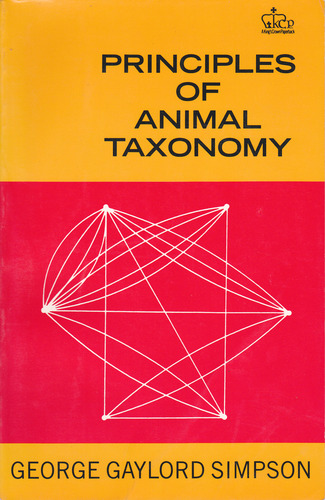Principles of animal taxonomy ebook
Par cota dale le vendredi, juillet 22 2016, 10:03 - Lien permanent
Principles of animal taxonomy by George Gaylord Simpson


Principles of animal taxonomy pdf
Principles of animal taxonomy George Gaylord Simpson ebook
Publisher: Columbia University Press
ISBN: 023109650X, 9780231096508
Format: djvu
Page: 131
History Among the dynamics in play here, we can see the general and specific principle at work. Most think that taxonomy is boring and difficult. Cuvier's The Animal Kingdom, Arranged According to its Organization, Serving as a Foundation for the Natural History of Animals, was an attempt to classify the animal kingdom on the basis of comparative anatomy, of which Cuvier's entire classification schema was Using these principles, Cuvier established a taxonomic approach based on comparative anatomy that established correlations between the inner systems that maintained life within an organism. The basic method of classifying the organisms has been the taxonomy. He studied botany and medicine and Of his higher groupings, only those for animals are still in use, and the groupings themselves have been significantly changed since their conception, as have the principles behind them. Icthyological Survey Techniques. The same principle has been applied to understand the enormously diversified biological organisms, mainly animals and plants. Herpetological Survey Techniques. The principle behind the method is illustrated in Figure 1, which shows a single species splitting into two independently evolving populations that gradually diverge over time. Yeah, it is difficult but it is not boring at all. Linnaeus, Carolus (kärō'ləs lĭnā'əs), 1707-78, Swedish botanist and taxonomist, considered the founder of the binomial system of nomenclature and the originator of modern scientific classification of plants and animals. Hunn [13] Our objective, in this study, is to record the fishers' knowledge in relation to cetaceans, with special emphasis on folk taxonomy (ethnotaxonomy), analyzing fishers' forms of classification and nomenclature of whales and dolphins in the Southeastern Brazilian coast. Biological Classification of Organisms. Introduction to Eco-systems of Pakistan. New York: Columbia University Press. Okay, so I was talking about FPJ 140 or ZOO 140 (Animal Taxonomy). Homologues, natural kinds and the evolution of modularity. The principles of naming new species of animals may seem like tedious legal work, but it can be fun—and sometimes you get to honor people as well with a new species named after them. The process of classifying and giving names to plants and animals was extensively studied by Berlin [3] who defines general principles to ethnobiological categorization and nomenclature. Simpson GG (1961) Principles of Animal Taxonomy.